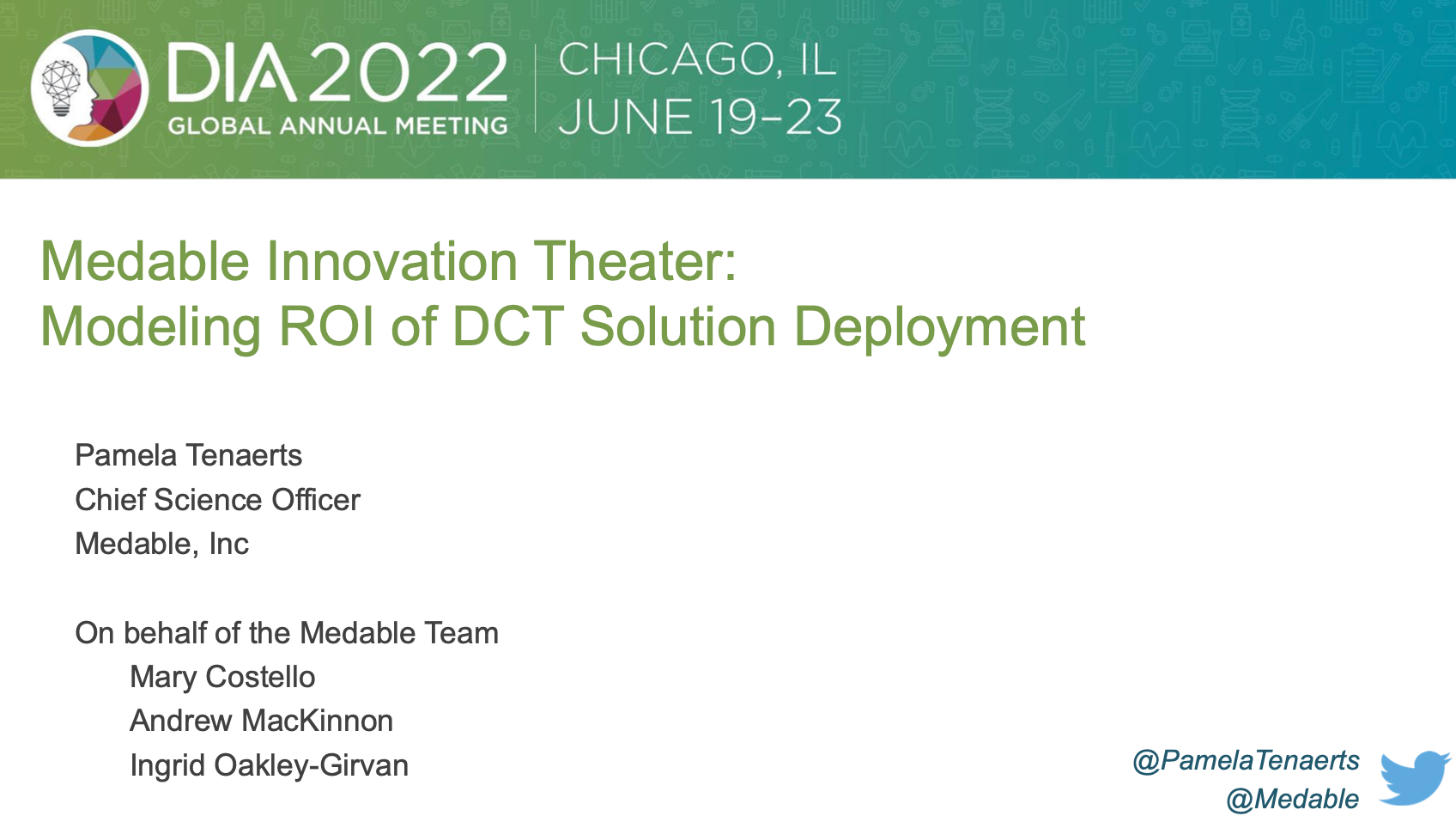New Data Reveals DCTs Yield Better Clinical Trial ROI

Decentralized clinical trials (DCTs) was a big topic at DIA this year, as the clinical trials industry started adopting more DCT methodologies. Many questions remain about the value of DCTs, but Ken Getz, executive director and research professor at the Tufts Center for The of Drug Development, shed some light on this new area with breakthrough findings with ROI and eNPV models.
Moe Alsumidaie: Why was DCTs an important topic, and why now?
Ken Getz: The pandemic necessitated rapid adoption of DCTs, but we've been discussing DCT deployments, experience, use cases, and anticipated impact for quite some time. DCT adoption has occurred without the normal phased adoption process that has time to unfold. Because it's been so rapid, the industry has a lot of questions on how to manage the best DCT moving forward, how to allocate resources, and where to invest. Organizations want to know how they can more intelligently manage DCT use.
Medable's Pam Tenaerts, MD, points out the definition of DCTs, so everyone reading is on the same page. We used CTTI's recently updated definition of DCT as those trials in which some or all study assessments or visits are conducted at locations other than the investigator site via any or all of the following DCT elements:
- Televisits
- Mobile, or local healthcare providers, including local labs and imaging centers
- Home delivery of investigational products
DCTs can be wholly remote or partially decentralized with hybrid approaches. For example, hybrid trials require some visits to be conducted on-site while other visits or assessments are performed at a participant's home or within their local care community.
Pam, who presented with me at the DIA Annual Meeting in June, and her team at Medable are determined to understand whether DCTs live up to expectations of better research. They are committed to providing metrics that indicate protocol performance improvements compared to brick-and-mortar trials…this is the first step on a journey to understanding the real benefits of DCTs.
Alsumidaie: Can you tell me more about the purpose of Tufts CSDD's study with Medable on DCTs? Why is this research necessary?
Getz: The Tufts eNPV study of DCTs is the first study quantifying the value of DCTs, specifically their return on investment or ROI. It's such a critical metric that's used to evaluate any investment. It's the most common metric to assess investment in new technology. ROI speaks a vital language, most notably to resource managers, senior management, and strategic and portfolio planners, and it can inform decision-making on DCT investments moving forward.
The Tufts center does a lot of expected net present value (eNPV) modeling studies. Medable took a leadership role, requesting that we evaluate the ROI of DCTs. This answers some critical questions that many companies are asking now, so it's very timely. Medable was remarkably perceptive in recognizing that this is something that would provide necessary insight now. Medable executives, including Pam Tenaerts, Mary Costello, Andrew McKinnon, Ingrid Oakley-Girvan, and of course, Michelle Longmire, are some of the people who are committed to gathering data and insights that will help us understand how to best leverage DCT solutions.
Alsumidaie: Speaking of data, can you discuss the study's methodologies and which KPIs the study focuses on?
Getz: Many eNPV modeling studies use anecdotal data or simply assumptions. It's essential to recognize that for this study, we're using actual data to populate the model.
There's a period before drug approval where the cash flows generated are negative—outflows or expenditures to cover all pre-approval development costs. Post-approval is when a period of inflows as the program enters the market and ramps up to achieve its sales potential. We discount that revenue stream, or cash flows, back to the current net present value. Our eNPV model begins with data on benchmarks from existing development programs.
Our model uses a typical drug development expense profile and commercialization revenue generation profile to develop a standard development program's overall cash flow life cycle.
For a development program supported by DCT, Tufts had data from a sample of nearly 200 protocols, where a subset indicated that they used a DCT solution. So, we could compare those roughly 150 protocols that did not use any DCT to that smaller subset of 33 protocols that used a DCT solution to assess DCT impact on clinical trial performance. Medable provided Tufts CSDD with de-identified contracts from 33 phase two and 22 phase three clinical trials so that we could populate the model with actual data on the cost to deploy a DCT solution. The DCT model was based on existing clinical trial performance and investment data.
When it comes to KPIs, the model looks at value drivers. What's driving a cost reduction? What's going a change in speed? These drivers change the shape of the cash outflows and inflows we are modeling. For example, a faster study will result in a shorter development time. So, the time that development expenses are being incurred is compressed, and there are other things like the quality of the clinical data and execution efficiencies that might also change the height or depth of the curve. All of these drivers modify the model. Then, we compare the expected net present value modeled with and without DCT to assess the financial impact—positive or negative. This is precisely how we develop an ROI for a DCT deployment.
Alsumidaie: Taking a closer look at that visualization of the eNPV, it seems that the cost of conducting research with DCT is slightly less than a traditional trial, especially in later phases. Could you explain that?
Getz: Technically, the direct or absolute cost may not be less. That's something we haven't determined. It's the time value. A dollar spent today is worth more than a dollar spent tomorrow because it's accruing interest. This curve is capturing 12 years, so we know that when we look at the capitalized cost, there are some savings because we're compressing time.
But the direct cost, I can't answer whether the absolute dollars are lower. They may be higher for a concise duration. There may be higher training costs and costs for the actual tech device or the technology itself. But when you discount the revenue stream, and you've had more time in the market for a drug to generate revenue before it loses its patent protection or exclusivity, that's where the real gain is achieved.
Alsumidaie: So, what about DCT drive speed and efficiency?
Getz: Our study already shows improvements in patient recruitment and retention. Dropout rates appear to be lower in our comparative assessment. Second, the screen failure rates improved, and that may be because there is greater decentralized access to a trial. More people who may be eligible are willing to inquire about participating in the study, essentially self-selecting because it appears to be a more accessible study to join in, either because it's conducted locally or there will be more opportunities to participate from home.
Third, with improvements in recruitment, there are often fewer protocol amendments. The number one reason we amend protocols is to relax the eligibility criteria. So that's another factor that we picked up here, and amendments add a lot of unbudgeted costs. A lower number of amendments is changing the cost curve measurably on the spending side of our product life cycle.
There are many other areas we haven't measured yet, but we hope to have data that will show the impact that DCT offers in the form of automation at the site execution level. For example, does it provide faster access to data? If so, we'll perhaps also see improvements in data management cycle times and data quality.
Alsumidaie: Were you able to assess patient diversity?
Getz: Unfortunately, we haven't been able to assess that yet. However, there's a possibility that we'll be doing a project in this area in the future. The Tufts Center is currently applying for a grant from a foundation to study population representation in DCTs.
Putting Collective Insights Into Action to Advance Cancer Care: Key Examples From ASCO 2025
June 27th 2025At ASCO 2025, clinical operations leaders gained critical insights into how AI tools, bispecific antibodies, and evolving treatment paradigms are reshaping trial design, endpoint selection, and patient stratification.
